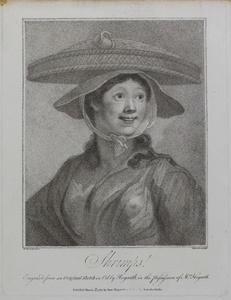| Method | Stipple |
| Artist | Francesco Bartolozzi after William Hogarth |
| Published | W. Hogarth pinx. F. Bartolozzi Sculp. Publish'd March 25th: 1782 by Jane Hogarth ___ Leicester Fields. [J & J Boydell c.1795] |
| Dimensions | Image 210 x 168 mm, Plate 272 x 205 mm |
| Notes |
A stipple engraving of a shrimp-seller by Bartolozzi, after an oil-sketch by Hogarth. The young woman is dressed in a diaphanous robe, her left breast visible through the sheer material. She wears a broad brimmed hat with her basket of shrimps on top, the whole tied under her chin with a ribbon. Her expression is one of youthful exuberance. An inscription below the title reads: 'Engrav'd from an original sketch in oil by Hogarth in the possession of Mrs Hogarth.' Francesco Bartolozzi (1727-1815) was an Italian engraver. The son of a goldsmith, Bartolozzi studied painting in Florence, trained as an engraver in Venice and began his career in Rome. In 1763 Richard Dalton, art dealer and librarian to George III, met him and invited him to London, promising him a post as engraver to the king. Bartolozzi moved to London the following year, and remained for thirty-five years. He executed numerous engravings for the King. He also made many engravings of paintings by Italian masters and by his friend, the painter Giovanni Cipriani. In 1768 Bartolozzi was the only engraver to become a founder member of the Royal Academy of Arts. He moved to Lisbon in 1802 as director of the National Academy. William Hogarth (1697 - 1764) was born in London, the son of an unsuccessful schoolmaster and writer from Westmoreland. After apprenticeship to a goldsmith, he began to produce his own engraved designs in about 1710. He later took up oil painting, starting with small portrait groups called conversation pieces. He went on to create a series of paintings satirising contemporary customs, but based on earlier Italian prints, of which the first was The Harlot's Progress (1731), and perhaps the most famous The Rake's Progress. His engravings were so plagiarised that he lobbied for the Copyright Act of 1735, commonly referred to as 'Hogarth's Act,' as a protection for writers and artists. During the 1730s Hogarth also developed into an original painter of life-sized portraits, and created the first of several history paintings in the grand manner. Calabi + De Vesme 1294. iii Condition: Trimmed to plate mark at top and bottom of sheet. Minor time toning and staining to top margin. |
| Framing | unmounted |
| Price | £150.00 |
| Stock ID | 50662 |

